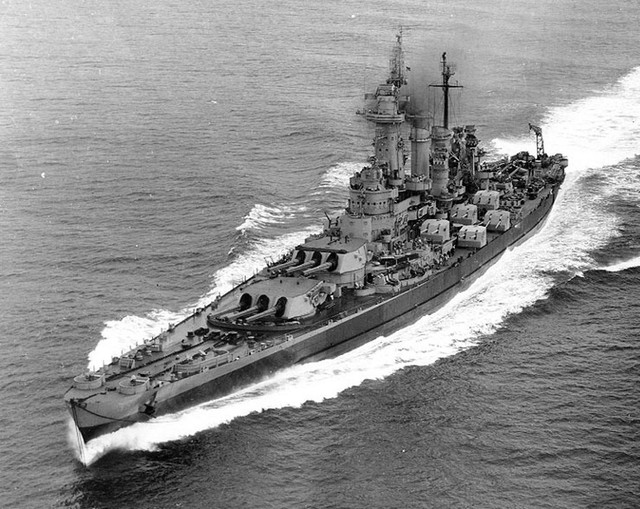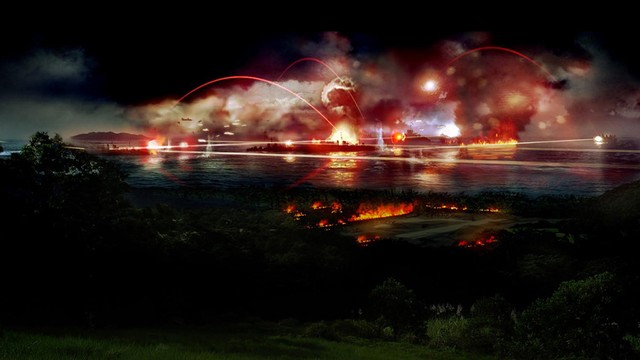It was not until the end of the war that the United States realized that it had suffered much more damage than Japan and had lost an unprecedented tactical loss.
November 12, 1942 – The naval battle of Guadalcanal begins to completely change the game in the Pacific theater
Operation Guadalcanal, by the Allied code name Operation Watchtower, took place from 7/8/1942 to 9/02/1943 on Guadalcanal and its environs in the Solomon Islands of the Pacific front during World War II. The dispute took place fiercely both on land, at sea and in the air; This campaign was the Allies’ first major offensive against the Empire of Japan after a long period of defense. The highlight of this campaign was the Naval Battle of Guadalcanal – one of the fiercest battles of WWII – which took place from November 12, 1942 to November 15, 1942. The naval battle involved several air raids and gunfire. fire between the ships over the course of four days, most of which were near Guadalcanal and involved the Japanese attempt to land troops on the island. This battle featured the only two US Navy admirals killed during the war.
It all started on August 8, 1942, when 11,000 Allied troops took control of Tulagi, the neighboring islands, and a Japanese airfield under construction at Lunga Point, later known as Henderson. To protect the airfield, the US Marines established a defensive perimeter around Lunga Point. Reinforcements arrived two months later, increasing the number of American troops at Lunga Point to 20,000 men. In response, the Japanese General Command tasked the 17th Army, a corps-sized unit stationed at Rabaul under the command of Lieutenant-General Hyakutake Harukichi, to retake Guadalcanal. 17th Army units began moving to Guadalcanal on August 19 to drive Allied forces off the island.
The Japanese army planned another attack on Guadalcanal in November 1942, but reinforcements were needed before the plan could be carried out. The military enlisted Yamamoto’s help in sending reinforcements to the island and assisting them in their assault on the Allied forces holding Henderson Field. To support the reinforcements, Yamamoto assembled 11 large transports to transport 7,000 men of the 38th Infantry Division and Rabaul ammunition, food and heavy equipment to Guadalcanal. He also sent warships from Truk to join the fleet on November 9, including two battleships. The two battleships Hiei and Kirishima were armed with high explosive shells (fragile) which were used to bomb Henderson on the night of 12/11 to 11/13, in order to destroy the airfield and the squadron of planes stationed there. and slow transports to Guadalcanal to land safely the next day. The fleet will be commanded by flagship Hiei, commanded by Vice Admiral Abe Hiroaki.

Abe Hiroaki’s fleet formed a formation 110 km north of the necessary strait and began advancing towards Guadalcanal on November 12, with the intention of arriving early the next morning on November 13. The slower convoy and 11 or 12 destroyers commanded by Tanaka Raizo began to enter New Georgia Sound from the Shortlands and were due to arrive at Guadalcanal on the night of November 13.
In addition to the two battleships, Abe’s fleet also included the light cruiser Nagara and 11 destroyers divided into two groups. Destroyer Group 10 was commanded by Major General Kimura Susumu and Destroyer Group 4 was commanded by Major General Takama Tamotsu. The three destroyers Shigure, Shiratsuyu and Yugure were on rearguard duty in the Russell Islands as Abe’s fleet entered the waters around northern Savo Island off Guadalcanal.
American reconnaissance planes detected the approach of the Japanese fleet and alerted the Allied commander. After receiving the warning, the Richmond K. Turner rounded up and separated all combatable ships in the convoy to protect the forces ashore at Guadalcanal against possible Japanese attacks and landings.
Admiral Daniel Callaghan was a few days older and was appointed commander, although Norman Scott had more experience. Callaghan prepares to engage the Japanese fleet at night in a fierce battle. Callaghan’s naval force consisted of two heavy cruisers, San Francisco and Portland, three light cruisers, Helena, Juneau and Atlanta, and eight other destroyers. Admiral Callaghan commanded the San Francisco.
Approaching Guadalcanal, the Japanese fleet entered an area of heavy and dense thunderstorms, and due to Abe’s complex training and confused orders, the Japanese fleet formation split into several groups. . The US fleet lined up in a long line around the Savo Sea, with destroyers in front and behind the defenses and cruisers in the center. The distance between destroyers and cruisers is 730 m, between cruisers is 640 m, and between destroyers is 460 m. All five ships were fitted with new radar sensors and had a long range, but Callaghan decided not to let them stand in front of the defenses and chose no ship as their flagship. Callaghan did not distribute the battle plan to the captains of his fleet.
At approximately 1:25 a.m. on November 13, in conditions of total darkness due to heavy rains and a waning moon, the Japanese fleet entered the strait between Savo and Guadalcanal, ready to bomb Henderson Field. Some American ships spotted the Japanese ships at 1:24 a.m. but had communication problems alerting Callaghan, due to their lack of experience in synchronous operation and the quality of the radio systems they were equipped with, as well as a lack of discipline in signaling communications.
A few minutes later, the two forces noticed each other almost simultaneously, but Abe Hiroaki and Daniel J. Callaghan hesitated to order their ships to attack immediately. Abe was almost baffled by the fact that the enemy fleet was so close he couldn’t decide whether to order a temporary retreat to give the battleships enough time to change HE shells (used for bombing) into anti-bullets. -ships, or continue forward. He decided to move on, as Callaghan was about to flank the Japanese fleet but was confused because he had received only incomplete information, and because the formation of the Japanese fleet was divided into small groups, he therefore gave confused fleet movement orders, and in general he took too long to act. The formation of American battleships began to deteriorate, contributing to Callaghan’s delay in giving the order to open fire, in order to define and reorganize the formation. As Japanese ships threaded their way between the American formations, captains on both sides eagerly awaited orders to fire.
At 1:48 a.m., Akatsuki and Hiei turned on their two searchlights in Atlanta just 1.7 miles away (which is the direct firing range of the large gunboats). Several ships on both sides began to shoot at each other sporadically. Realizing that his force was surrounded by Japanese ships, Callaghan ordered the “odd ships to fire to starboard, even ships to starboard”, only before battle broke out, the ships had no assigned numbers and the battleship formations. were inherently chaotic. All of the remaining unarmed US ships opened fire, and several more had to shift targets to respond to Callaghan’s orders. The two forces were in an entangled position, firing melee artillery at each other in a chaotic fashion like the naval battles of previous centuries. Monssen’s navigator described the battle as “like a riot in a bar with the lights out”. Meanwhile, Robert Leckie, a US Navy who witnessed the Battle of Guadalcanal, said: “The flames have gone up high, terrible and red. Huge flares swept through the night. glass stone on which the warships seemed to fall, motionless, causing the center of the circles to spread out like stones fallen in the mud “.

After 40 minutes of intense melee combat, the fleets of the two camps began to gradually separate and cease fire at 2:26 a.m. after Abe and Captain Gilbert Hoover (Helena captain and the fleet’s oldest commander Chinese) Ky survived until then) ordered a ceasefire. On the Abe side, a battleship, a light cruiser and four destroyers suffered only minor damage and four other destroyers were moderately damaged. On the American side, only a light cruiser and a destroyer are still capable of responding. Although Abe may not have realized it, the situation did not allow his fleet to bombard Henderson Field and completely destroy the US fleet, creating a safe zone to land reinforcements and supplies. . . Whatever the reason, Abe ordered the ceasefire and withdrew all warships from the area, although Yukikaze and Teruzuki stayed to help Hiei.
At around 3 a.m. on November 13, Admiral Yamamoto postponed the convoy’s disembarkation plan and all returned to the Shortlands to await further orders. At dawn, the three crippled Japanese ships Hiei, Yudachi, and Amatsukaze and three other crippled US ships Portland, Atlanta, and Aaron Ward stretch off the coast around Savo Island. The tugboat Bobolink sailed the waters of New Georgia Sound throughout the day of 11/13 to assist US ships and survivors and report the shooting of all Japanese survivors floating on the water. Due to the confusion over the nature of the battle, the United States believed that it had sunk at least seven Japanese ships. Moreover, the Japanese withdrawal made the United States believe they had won. It was not until the end of the war that the United States realized that it had suffered much more damage than Japan and had lost an unprecedented tactical loss.
It was Japan’s last major naval battle in an attempt to recapture Henderson Airfield or to encircle the surrounding waters. The US Navy successfully resupplied its forces at Guadalcanal, including the arrival of two divisions in late December 1942. Failure to neutralize Henderson made all Japanese efforts a failure against US forces attacking Guadalcanal. The last Japanese resistance came at the end of Guadalcanal on February 9, 1943, when Japan evacuated all forces from all the islands in Operation Ke. Winning the Guadalcanal campaign helped the Allies fortify themselves elsewhere in the region and helped end World War II when Japan surrendered. US President Franklin Roosevelt said after seeing the outcome of the battle: “It seems that the turning point in the war has been won.”


